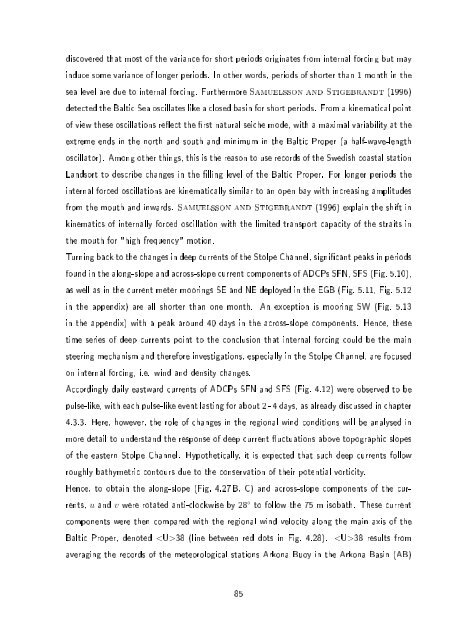Baltic Sea
Baltic Sea
Baltic Sea
Create successful ePaper yourself
Turn your PDF publications into a flip-book with our unique Google optimized e-Paper software.
discovered that most of the variance for short periods originates from internal forcing but may<br />
induce some variance of longer periods. In other words, periods of shorter than 1 month in the<br />
sea level are due to internal forcing. Furthermore Samuelsson and Stigebrandt (1996)<br />
detected the <strong>Baltic</strong> <strong>Sea</strong> oscillates like a closed basin for short periods. From a kinematical point<br />
of view these oscillations reect the rst natural seiche mode, with a maximal variability at the<br />
extreme ends in the north and south and minimum in the <strong>Baltic</strong> Proper (a half-wave-length<br />
oscillator). Among other things, this is the reason to use records of the Swedish coastal station<br />
Landsort to describe changes in the lling level of the <strong>Baltic</strong> Proper. For longer periods the<br />
internal forced oscillations are kinematically similar to an open bay with increasing amplitudes<br />
from the mouth and inwards. Samuelsson and Stigebrandt (1996) explain the shift in<br />
kinematics of internally forced oscillation with the limited transport capacity of the straits in<br />
the mouth for "high frequency" motion.<br />
Turning back to the changes in deep currents of the Stolpe Channel, signicant peaks in periods<br />
found in the along-slope and across-slope current components of ADCPs SFN, SFS (Fig. 5.10),<br />
as well as in the current meter moorings SE and NE deployed in the EGB (Fig. 5.11, Fig. 5.12<br />
in the appendix) are all shorter than one month. An exception is mooring SW (Fig. 5.13<br />
in the appendix) with a peak around 40 days in the across-slope components. Hence, these<br />
time series of deep currents point to the conclusion that internal forcing could be the main<br />
steering mechanism and therefore investigations, especially in the Stolpe Channel, are focused<br />
on internal forcing, i.e. wind and density changes.<br />
Accordingly daily eastward currents of ADCPs SFN and SFS (Fig. 4.12) were observed to be<br />
pulse-like, with each pulse-like event lasting for about 2 - 4 days, as already discussed in chapter<br />
4.3.3. Here, however, the role of changes in the regional wind conditions will be analysed in<br />
more detail to understand the response of deep current uctuations above topographic slopes<br />
of the eastern Stolpe Channel. Hypothetically, it is expected that such deep currents follow<br />
roughly bathymetric contours due to the conservation of their potential vorticity.<br />
Hence, to obtain the along-slope (Fig. 4.27 B, C) and across-slope components of the currents,<br />
u and v were rotated anti-clockwise by 28 ◦ to follow the 75 m isobath. These current<br />
components were then compared with the regional wind velocity along the main axis of the<br />
<strong>Baltic</strong> Proper, denoted 38 (line between red dots in Fig. 4.28). 38 results from<br />
averaging the records of the meteorological stations Arkona Buoy in the Arkona Basin (AB)<br />
85



